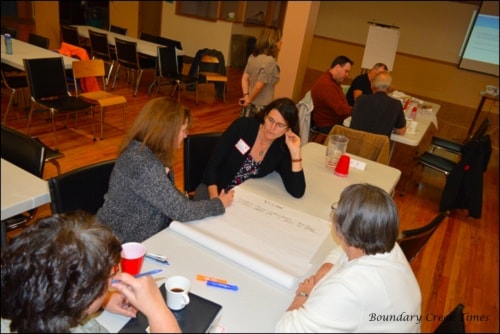It is early days in the formation of the economic development committee, but possible goals have been identified and meetings will continue following Greenwood’s public economic development strategic planning session that was held on Thursday, Nov. 7 at McArthur Centre.
The meeting was facilitated by Dr. Kyleen Myrah, CMA, Professor at Okanagan School of Business.
Also present were Mayor Nipper Kettle, Greenwood Board of Trade president Jim Nathorst, Boundary Country Regional Chamber of Commerce Executive Director James Wilson, Community Futures Boundary General Manager Wendy McCulloch and other residents, mostly members of the BOT but other organizations were represented as well.
According to Kettle a bout two dozen people turned out for the meeting. The attendees were divided into groups at the outset and each was asked to identify their group’s vision for the city over the next three years.
Next participants were asked to pinpoint strengths that the city can build upon. There was agreement that their location on Hwy 3 and the proximity to major centres were key assets. Also the fact that Greenwood is a four-season community with award winning water and a healthy environment with plenty of outdoor recreation opportunities. The history of the area and the unique heritage building also made the list, as did the fact that the community has a local doctor for one’s physical needs as well as a number of high quality artisans for their cultural desires.
However several challenges were also identified. The difficulty in attracting and retaining businesses was seen as a major stumbling block, as was the city’s small tax base with no big industrial business located here.
While having a highway run through town was identified as a strength - getting that traffic to stop was seen as a challenge. A lack of low-cost housing for seniors and limited access to health care were also noted as challenges.
Other barriers to development discussed were limited access to broadband, unsightly premises and lack of pride in the community by some, the number of vacant buildings on main street that give tourists the impression of a recession, the lack of documentation on the history and heritage of the community that is assessable to tourists, lack of public washrooms and finally the fact that the sidewalks seem to be rolled up at 5 p.m.
Each table was asked to pick three opportunities that could be achieved within the next year and then to try to sell the rest of the room on those ideas.
Nine ideas were generated: The top three chosen by the room were signage, window displays and beautification.
Also identified as goals achievable within the next 12 months but falling off the radar for the rest of the evening were the creation a water station, development of a brand and name, a pedestrian crossing, quality public washrooms, establishment of festivals and events and finally providing free camping.
The group was then divided into three groups, each focusing on one of the three ideas. Their task was to develop a picture of what the idea looks like, who are the persons responsible, and when it can happen.
The group devoted to signage talked about the need for quality signage with a heritage theme that would be located on Hwy 33 and both east and west on Hwy 3. It was felt that responsibility for the project should be jointly handled between the BOT and City Council and that it have a deadline of 2014, “no ifs, ands or buts.” Thoughts for fundraising for signage included the city, BOT, a fundraising dance and interested individuals.
The team working on beautification narrowed their discussion to development of a water station, mining carts, trees, flowers and a sitting area. They suggested a clean up of downtown areas and that work begin with development of a conceptual drawing. Groups identified as potential partners on beautification included community groups, the BOT, the City, the Greenwood Legacy Group and the Museum. They agreed that further research was needed about costs, a source for mining carts, necessary permits, etc.
The table dedicated to window displays went far beyond simple displays to include the possibility of having actors performing street theatre for the tourists—such as having in a bad guy arrested and escorted to the jail in the court house or having red light district girls and miners throughout town performing skits. It was thought that local residents and businesses might be able to pull it off using the courthouse, hotel, museum archives and researchers.
“The group worked well together and seemed determined to move this project along,” McCulloch said in an email to the Times following the planning session.
